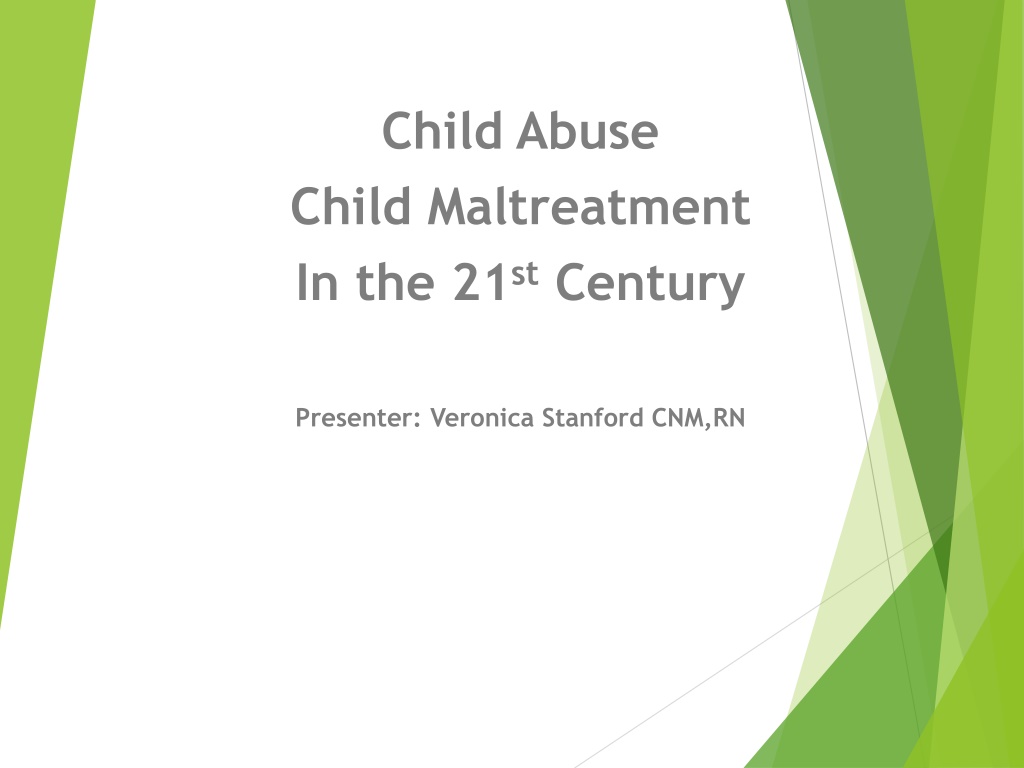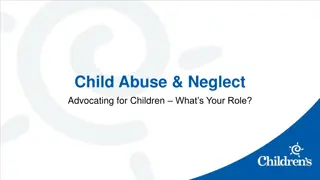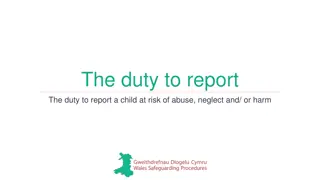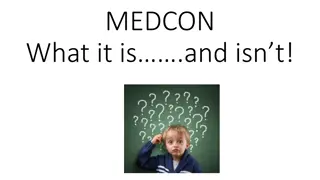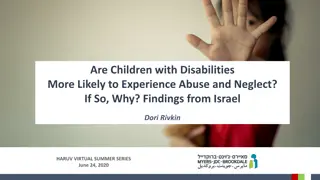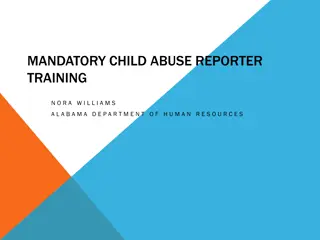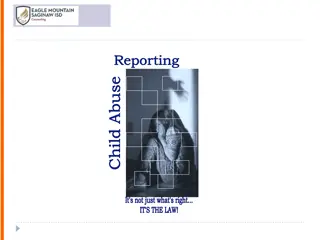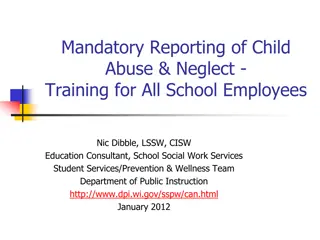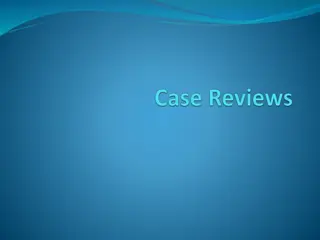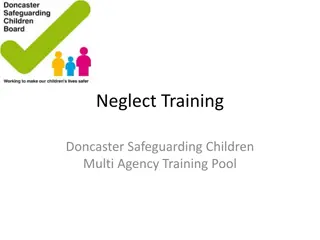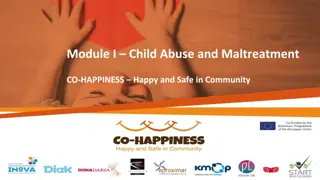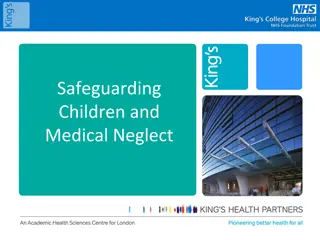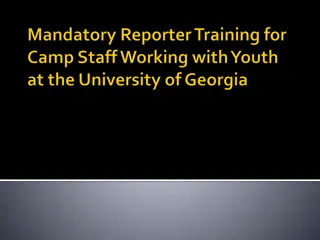Child Abuse and Neglect in the 21st Century
Child abuse and neglect are serious issues affecting millions of children worldwide. This course by presenter Veronica Stanford sheds light on identifying, reporting, and preventing various forms of maltreatment, including physical abuse, sexual exploitation, and neglect. The content delves into the definition of maltreatment, forms of abuse, indicators of neglect, and the role of mandatory reporters in safeguarding children's well-being. The World Health Organization presents alarming facts, highlighting the lifelong consequences of child maltreatment and emphasizing the importance of breaking the cycle of violence for positive multi-generational impacts.
Download Presentation

Please find below an Image/Link to download the presentation.
The content on the website is provided AS IS for your information and personal use only. It may not be sold, licensed, or shared on other websites without obtaining consent from the author.If you encounter any issues during the download, it is possible that the publisher has removed the file from their server.
You are allowed to download the files provided on this website for personal or commercial use, subject to the condition that they are used lawfully. All files are the property of their respective owners.
The content on the website is provided AS IS for your information and personal use only. It may not be sold, licensed, or shared on other websites without obtaining consent from the author.
E N D
Presentation Transcript
Child Abuse Child Maltreatment In the 21stCentury Presenter: Veronica Stanford CNM,RN
Goal After completing this course, you should be able to: Know how and when to report suspected incidents of child abuse. State examples of indicators of neglect, physical and sexual abuse Explain how to acknowledge students concerns about others Identify your role as a mandatory reporter and describe the reporting process
Child Abuse and Neglect Definition: Maltreatment is the abuse and neglect that occurs to children under 18 years of age, includes all types of physical and/or emotional ill-treatment, sexual abuse, neglect, negligence and commercial or other exploitation, which results in actual or potential harm to the child s health and survival.
Forms of Maltreatment There are two basic forms of Child maltreatment abuse and neglect Physical abuse Sexual abuse and sexual exploitation Mental and emotional abuse Physical neglect Mental or emotional neglect Medical neglect Threat of harm
Child Abuse and Neglect A neglected child physical and/or mental welfare is harmed or threatened with harm by acts of failures to act by his or her parent or other person responsible for his or her welfare. Child maltreatment is the abuse and neglect that occurs to children under 18 years of age. Includes all types of physical and/or emotional ill- treatment, sexual abuse, neglect, negligence and commercial or other exploitation, which results in Actual or potential harm to the child s health, survival, development or dignity in the context of a relationship of trust or power
World Health Organization Recent Facts of Child Abuse Nearly 3 in 4 children - or 300 million children - aged 2 4 years regularly suffer physical punishment and/or psychological violence at the hands of parents and caregiver One in 5 women and 1 in 13 men report having been sexually abused as a child aged 0-17 years. 120 million girls and young women under 20 years of age have suffered some form of forced sexual contact. Consequences of child maltreatment include impaired lifelong physical and mental health. Child maltreatment is often hidden. Only a fraction of child victims of maltreatment ever gets support from health professionals. A child who is abused is more likely to abuse others as an adult so that violence is passed down from one generation to the next. It is therefore critical to break this cycle of violence, and in so doing create positive multi-generational impacts.
Prevention Approach Preventing child maltreatment before it starts is possible and requires a multisector approach. Effective prevention approaches include supporting parents and teaching positive parenting skills, and enhancing laws to prohibit violent punishment. Ongoing care of children and families can reduce the risk of maltreatment reoccurring and can minimize its consequences.
Scope of the Problem Child maltreatment is a global problem with serious life-long consequences. In spite of recent national surveys in several low- and middle-income countries, data from many countries are still lacking. Child maltreatment is complex and difficult to study. Current estimates vary widely depending on the country and the method of research used. Estimates depend on: the definitions of child maltreatment used the type of child maltreatment studied the coverage and quality of official statistics the coverage and quality of surveys that request self- reports from victims, parents or caregivers.
Scope of the Problem Contd International studies reveal that nearly 3 in 4 children aged 2-4 years regularly suffer physical punishment and/or psychological violence at the hands of parents and caregivers, and 1 in 5 women and 1 in 13 men report having been sexually abused as a child.
Scope of the Problem Contd International studies reveal that nearly 3 in 4 children aged 2-4 years regularly suffer physical punishment and/or psychological violence at the hands of parents and caregivers, and 1 in 5 women and 1 in 13 men report having been sexually abused as a child.
Scope of the Problem Contd Every year, there are an estimated 40150 homicide deaths in children under 18 years of age, some of which are likely due to child maltreatment. This number almost certainly underestimates the true extent of the problem, since a significant proportion of deaths due to child maltreatment are incorrectly attributed to falls, burns, drowning and other causes.
Scope of the Problem Contd In armed conflict and refugee settings, girls are particularly vulnerable to sexual violence, exploitation and abuse by combatants, security forces, members of their communities, aid workers and others
Consequences of maltreatment Severe short- and long-term physical, sexual and mental health consequences. Injuries, including head injuries and severe disability, in particular in young children; post- traumatic stress, anxiety, depression, and sexually transmitted infections (STIs) including HIV. Adolescent girls may face additional health issues, including gynecological disorders and unwanted pregnancy. Cognitive and academic performance affected strongly associated with alcohol and drug abuse and smoking cardiovascular diseases and cancer.
Consequences Contd perpetrating or being a victim of violence depression smoking obesity high-risk sexual behaviors unintended pregnancy Alcohol and drug misuse
Negative effects of Child Abuse Violence against children is also a contributor to inequalities in education. Children who experienced any form of violence in childhood have a 13% greater likelihood of not graduating from school Statistic of High School Drop-out
Risk Factors Children are the victims and are never to blame for maltreatment. Child Characteristics: being either under four years old or an adolescent being unwanted, or failing to fulfil the expectations of parents having special needs, crying persistently or having abnormal physical features having an intellectual disability or neurological disorder identifying as or being identified as lesbian, gay, bisexual or transgender
Data and Proactive Approach Health Care professionals Responsibilities Child and Adolescent sexual abuse (CSA) are a 21st century reality and it remains a cause of concern to parents, teachers, Government of nations as well as researchers all over the world. An annual estimation of 73 Million boys and 150 Million girls are involved in one form of sexual abuse or the other before their 18th birthday. (Information from East, Central and Southern African Health Community (ECSA_HC) 2011: bringing global prevalence rates between 3-17% in boys 8-31% in girls. This study adopts the definition of the United Nations Convention for the rights Removing Barriers to Learning Recognize when child is Bruised or injured Intervene on their behalf Responsibilities of School Staff First to come in contact
Risk Factor Parent or caregiver difficulty bonding with a newborn not nurturing the child having been maltreated themselves as a child lacking awareness of child development or having unrealistic expectations misusing alcohol or drugs, during pregnancy having low self-esteem suffering from poor impulse control having a mental or neurological disorder being involved in criminal activity experiencing financial difficulties.
Risk Factor Relationship Characteristics of the relationships within families family breakdown or violence between other family members being isolated in the community or lacking a support network A breakdown of support in child rearing from the extended family.
Risk Factors Community and societal factors gender and social inequality; lack of adequate housing or services to support families and institutions high levels of unemployment or poverty the easy availability of alcohol and drugs inadequate policies and programs to prevent child maltreatment, child pornography, child prostitution and child labor social and cultural norms that promote or glorify violence towards others, support the use of corporal punishment, demand rigid gender roles, or diminish the status of the child in parent child relationships Social, economic, health and education policies that lead to poor living standards, or to socioeconomic inequality or instability.
Prevention Earlier such interventions occur the greater the benefits Effective and promising interventions include: Parent and caregiver support: Information and skill-building sessions to support the nurturing, non-violent parenting, by nurses, social workers, or trained lay workers through a series of home visits or in a community setting.
Prevention Education and life skills approaches: Increasing enrolment in quality education to allow children to acquire knowledge, skills and experiences Programs to prevent sexual abuse, that build awareness and teach skills to help children and adolescents avoid and prevent sexual abuse and exploitation, and to seek help and support Interventions to build a positive school climate and violence-free environment, and strengthening relationships between students, teachers, and administrators .
Prevention Contd Norms and values approaches: Programs to transform restrictive and harmful gender and social norms around child-rearing, child discipline and gender equality and promote the nurturing role of fathers Implementation and enforcement of laws to prohibit violent punishment and to protect children from sexual abuse and exploitation. Response and support services: Early case recognition combined with ongoing care of child victims and families, to help reduce reoccurrence of maltreatment and lessen its consequences
Prevention Contd To maximize the effects of prevention and care, WHO recommends that interventions are delivered as part of a four-step public health approach: defining the problem; identifying causes and risk factors; designing and testing interventions aimed at minimizing the risk factors; distributing information about the effectiveness of interventions and increasing the scale of proven effective interventions.
World Health Organization response WHO, in collaboration with partners: provides guidance for evidence-based child maltreatment prevention; see INSPIRE Seven strategies to end violence against children provides evidence-based guidance to help frontline healthcare providers recognize children who have suffered from violence and neglect and provide evidence-based first line support; see Responding to child maltreatment: a clinical handbook for health professionals. advocates for increased international support for and investment in evidence-based child maltreatment prevention; provides technical support for evidence-based child maltreatment prevention programs in several low- and middle-income countries WHO, in collaboration with partners: provides guidance for evidence-based child maltreatment prevention; see INSPIRE Seven strategies to end violence against children provides evidence-based guidance to help frontline healthcare providers recognize children who have suffered from violence and neglect and provide evidence-based first line support; see Responding to child maltreatment: a clinical handbook for health professionals. advocates for increased international support for and investment in evidence-based child maltreatment prevention; provides technical support for evidence-based child maltreatment prevention programs in several low- and middle-income countries
Recognizing and Reporting Removing Barriers to Learning Recognize when child is abused Intervene on their behalf Anyone who suspects child abuse Responsibilities of Health care-providers, Social Workers Responsibilities of all School Staff First to come in contact Be aware of your legal responsibilities Identification, intervention, and prevention of child abuse
Conclusion Child and Adolescent sexual abuse (CSA) are a 21st century reality and it remains a cause of concern to parents, teachers, Government of nations as well as researchers all over the world. An annual estimation of 73 Million boys and 150 Million girls are involved in one form of sexual abuse or the other before their 18th birthday. (Information from East, Central and Southern African Health Community (ECSA_HC) 2011: bringing global prevalence rates between 3-17% in boys 8-31% in girls. This study adopts the definition of the United Nations Convention for the rights
Reporting Child Abuse in Nigeria 24-Hour Helpline Helps You Able to arrange for emergency intervention within Lagos State & Abuja, and currently provides referral services elsewhere in Nigeria. Calls to 0800 800 8001 are free. This line is specifically for children
Child Abuse in the 21st Century Questions Comments & Concerns
